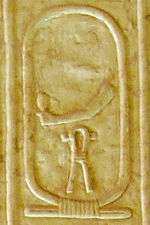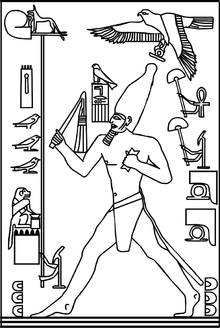Djoser
| Djoser | |||||||||||||||||||||||||||||||||||||||||||||||||||||||||||||||||||||||||||||||||||||
|---|---|---|---|---|---|---|---|---|---|---|---|---|---|---|---|---|---|---|---|---|---|---|---|---|---|---|---|---|---|---|---|---|---|---|---|---|---|---|---|---|---|---|---|---|---|---|---|---|---|---|---|---|---|---|---|---|---|---|---|---|---|---|---|---|---|---|---|---|---|---|---|---|---|---|---|---|---|---|---|---|---|---|---|---|---|
| Netjerikhet, Tosorthros, Sesorthos | |||||||||||||||||||||||||||||||||||||||||||||||||||||||||||||||||||||||||||||||||||||
 Limestone statue of Djoser from his serdab | |||||||||||||||||||||||||||||||||||||||||||||||||||||||||||||||||||||||||||||||||||||
| Pharaoh | |||||||||||||||||||||||||||||||||||||||||||||||||||||||||||||||||||||||||||||||||||||
| Reign | 19 or 28 years ca. 2670 BC (3rd Dynasty) | ||||||||||||||||||||||||||||||||||||||||||||||||||||||||||||||||||||||||||||||||||||
| Predecessor | Khasekhemwy (most likely) or Nebka | ||||||||||||||||||||||||||||||||||||||||||||||||||||||||||||||||||||||||||||||||||||
| Successor | Sekhemkhet (most likely) or Sanakhte | ||||||||||||||||||||||||||||||||||||||||||||||||||||||||||||||||||||||||||||||||||||
| |||||||||||||||||||||||||||||||||||||||||||||||||||||||||||||||||||||||||||||||||||||
| Consort | Hetephernebti | ||||||||||||||||||||||||||||||||||||||||||||||||||||||||||||||||||||||||||||||||||||
| Children | Inetkawes, maybe Sekhemkhet ? | ||||||||||||||||||||||||||||||||||||||||||||||||||||||||||||||||||||||||||||||||||||
| Father | Khasekhemwy | ||||||||||||||||||||||||||||||||||||||||||||||||||||||||||||||||||||||||||||||||||||
| Mother | Nimaethap | ||||||||||||||||||||||||||||||||||||||||||||||||||||||||||||||||||||||||||||||||||||
| Burial | Step pyramid at Saqqara | ||||||||||||||||||||||||||||||||||||||||||||||||||||||||||||||||||||||||||||||||||||
| Monuments | Step pyramid | ||||||||||||||||||||||||||||||||||||||||||||||||||||||||||||||||||||||||||||||||||||

Djoser (also read as Djeser and Zoser) was an ancient Egyptian pharaoh of the 3rd dynasty during the Old Kingdom and the founder of this epoch. He is well known under his Hellenized names Tosorthros (from Manetho) and Sesorthos (from Eusebius). He was the son of king Khasekhemwy and queen Nimaathap, but if he also was the direct throne successor is still unclear. Most Ramesside Kinglists name a king Nebka before him, but since there are still difficulties in connecting that name with contemporary horus names, some Egyptologists question the received throne sequence.
Identity

The painted limestone statue of Djoser, now in the Egyptian Museum in Cairo, is the oldest known life-sized Egyptian statue.[2] Today at the site in Saqqara where it was found, a plaster copy of the statue stands in place of the original. The statue was found during the Antiquities Service Excavations of 1924–1925.
In contemporary inscriptions, he is called Netjerikhet, meaning "divine of body." Later sources, which include a New Kingdom reference to his construction, help confirm that Netjerikhet and Djoser are the same person.
While Manetho names Necherophes and the Turin King List names Nebka as the first ruler of the Third dynasty, many Egyptologists now believe Djoser was first king of this dynasty, pointing out that the order in which some predecessors of Khufu are mentioned in the Papyrus Westcar suggests Nebka should be placed between Djoser and Huni, not before Djoser. More significantly, the English Egyptologist Toby Wilkinson has demonstrated that burial seals found at the entrance to Khasekhemwy's tomb in Abydos name only Djoser, rather than Nebka. This supports the view that it was Djoser who buried and, hence, directly succeeded Khasekhemwy, rather than Nebka.[3]
Family
Because Queen Nimaethap, the wife of Khasekhemwy, the last king of the Second dynasty of Egypt, is mentioned on a jar sealing of Khasekhemwy with the title "Mother of the King's children", some writers argue she was Djoser's mother and Khasekhemwy was his father. This is also suggested by another jar sealing, dating to Djoser's reign, calling her "Mother of the King of the Two Lands". Her cult seems to have still been active in the later reign of Sneferu.
Hetephernebti is identified as one of Djoser's queens "on a series of boundary stela from the Step Pyramid enclosure (now in various museums) and a fragment of relief from a building at Hermopolis" currently in the Egyptian museum of Turin.[4]
Inetkawes was their only daughter known by name. There was also a third royal female attested during Djoser's reign, but her name is destroyed. The relationship between Djoser and his successor, Sekhemkhet, is not known, and the date of his death is uncertain.
Reign
Length of reign
Manetho states Djoser ruled Egypt for twenty-nine years, while the Turin King List states it was only nineteen years. Because of his many substantial building projects, particularly at Saqqara, some scholars argue Djoser must have enjoyed a reign of nearly three decades. Manetho's figure appears to be more accurate, according to Wilkinson's analysis and reconstruction of the Royal Annals. Wilkinson reconstructs the Annals as giving Djoser "28 complete or partial years", noting that the cattle counts recorded on Palermo stone register V, and Cairo Fragment 1, register V, for the beginning and ending of Djoser's reign, would most likely indicate his regnal years 1–5 and 19–28. Unfortunately, next to all entrances are illegible today. The Year of coronation is preserved, followed by the year events receiving the twin-pillars and stretching the cords for the fortress Qau-Netjerw ("hills of the gods").[5]
Political activities

Djoser dispatched several military expeditions to the Sinai Peninsula, during which the local inhabitants were subdued. He also sent expeditions there to mine for valuable minerals such as turquoise and copper. This is known from inscriptions found in the desert there, sometimes displaying the banner of Seth alongside the symbols of Horus, as had been more common under Khasekhemwy. The Sinai was also strategically important as a buffer between the Nile valley and Asia.
His most famous monument was his step pyramid, which entailed the construction of several mastaba tombs one over another.[6] These forms would eventually lead to the standard pyramid tomb in the later Old Kingdom. Manetho, many centuries later, alludes to architectural advances of this reign, mentioning that "Tosorthros" discovered how to build with hewn stone, in addition to being remembered as the physician Aesculapius, and for introducing some reforms in the writing system. Modern scholars think that Manetho originally ascribed (or meant to ascribe) these feats to Imuthes, who was later deified as Aesculapius by the Greeks and Romans, and who corresponds to Imhotep, the famous minister of Djoser who engineered the Step Pyramid's construction.
Some fragmentary reliefs found at Heliopolis and Gebelein mention Djoser's name and suggest he commissioned construction projects in those cities. Also, he may have fixed the southern boundary of his kingdom at the First Cataract. An inscription known as the Famine Stela and claiming to date to the reign of Djoser, but probably created during the Ptolemaic Dynasty, relates how Djoser rebuilt the temple of Khnum on the island of Elephantine at the First Cataract, thus ending a seven-year famine in Egypt. Some consider this ancient inscription as a legend at the time it was inscribed. Nonetheless, it does show that more than two millennia after his reign, Egyptians still remembered Djoser.
Although he seems to have started an unfinished tomb at Abydos (Upper Egypt), Djoser was eventually buried in his famous pyramid at Saqqara in Lower Egypt. Since Khasekhemwy, a pharaoh from the 2nd dynasty, was the last pharaoh to be buried at Abydos, some Egyptologists infer that the shift to a more northerly capital was completed during Djoser's time.
Djoser and Imhotep
One of the most famous contemporaries of king Djoser was his vizier, "head of the royal shipyard" and "overseer of all stone works", Imhotep. Imhotep oversaw stone building projects such as the tombs of King Djoser and King Sekhemkhet. It is possible that Imhotep was mentioned in the also famous Papyrus Westcar, in a story called "Khufu and the magicians". But because the papyrus is badly damaged at the beginning, Imhotep's name is lost today. A papyrus from the ancient Egyptian temple of Tebtunis, dating to the 2nd century AD, preserves a long story in the demotic script about Djoser and Imhotep. At Djoser's time Imhotep was of such importance and fame that he was honoured by being mentioned on statues of king Djoser in his necropolis at Saqqara.
Tomb



Djoser was buried in his famous step pyramid at Saqqara. This pyramid was originally built as a nearly quadratic mastaba, but then five further mastabas were literally piled upon the first, each new mastaba smaller than the predecessing ones, until the monument became Egypt's first step pyramid. Supervisor of the building constructions was the high lector priest Imhotep.
The pyramid

The step pyramid is made of limestone. It is massive and contains only one tight corridor leading to the close midst of the monument, ending in a rough chamber where the entrance to the tomb shaft was hidden. This inner construction was later filled with rubble, for it was of no use anymore. The pyramid was once 62 metres high and had a base measurement of ca. 125 X 109 metres. It was tightly covered in finely polished, white limestone.[7]
Subterranean structure

Beneath the step pyramid, a large maze of corridors and chambers were dug. The burial chamber lies in the midst of the subterranean complex, a 28 metres deep shaft leads directly from the surface down to the burial. The shaft entrance was sealed by a plug stone with a weight of 3.5 tons. The subterranean burial maze contains four magazine galleries, each pointing straight to one cardinal direction. The eastern gallery contained three limestone reliefs depicting king Djoser during the celebration of the Hebsed (rejuvenation feast). The walls around and between these reliefs were decorated with blueish fayence tiles. They were thought to imitate reed mats, as an allusion to the mythological underworld waters. The other galleries remained unfinished.
At the eastern site of the pyramid, very close to the blue chambers, eleven tomb shafts lead straight down for 30 – 32 metres deep and then deviate in a right angle in western direction. Shaft I – V were used for the burials of royal family members, shaft VI – XI were used as symbolic tombs for the grave goods of royal ancestors from dynasty I – II. More than 40,000 vessels, bowls and vases made of all kind of semiprecious stone were found in these galleries. Royal names such as of kings Den, Semerkhet, Nynetjer and Sekhemib were incised on the pots. It is now thought that Djoser once restored the original tombs of the ancestors and then sealed the grave goods in the galleries in attempt to save them.
Necropolis complex
Djoser's step pyramid was surrounded by a 10.5 metres high niched enclosure wall, building an inner courtyard of 37.06 acres (15 ha). This courtyard contains several cultic buildings, such as the Southern Tomb, the Southern Courtyard, the Southern Pavillon, the Northern Pavillon, the Entrance Colonnade and the Serdab with the famous seating statue of Djoser.
References
- ↑ For unknown reasons the first sign was deliberately removed.
- ↑ Berrett 1996, p. 265.
- ↑ Toby Wilkinson, Early Dynastic Egypt, Routledge, 1999, pp.83 & 95
- ↑ Aidan Dodson & Dyan Hilton, The Complete Royal Families of Ancient Egypt, Thames & Hudson (2004), p.48
- ↑ Toby Wilkinson, Royal Annals of Ancient Egypt, pp.79 & 258
- ↑ Atiya 2006, p. 103.
- ↑ Harry Adès A Traveller's History of Egypt (Chastleton Travel/Interlink, 2007) ISBN 1-905214-01-4 p48
- Bibliography
- Atiya, Farid (1 January 2006). Ancient Egypt. American Univ in Cairo Press. ISBN 978-977-17-3634-9.
- Berrett, LaMar C. (1 April 1996). Discovering the World of the Bible. Cedar Fort. ISBN 978-0-910523-52-3.
Further reading
- Rosanna Pirelli, "Statue of Djoser" in Francesco Tiradritti (editor): The Treasures of the Egyptian Museum. American University in Cairo Press, Cairo 1999, p. 47.
- Toby Wilkinson: Early Dynastic Egypt. Routledge, London 2001, pp. 83 & 95
- Toby Wilkinson: Royal Annals of Ancient Egypt: The Palermo Stone and Its Associated Fragments. Kegan Paul International, London 2000.
- I. E. S. Edwards: The Pyramids of Egypt. West Drayton 1947; Rev. ed. Harmondsworth 1961; Rev. ed. Harmondsworth 1985 (dt. Ausgabe Die ägyptischen Pyramiden, 1967)
External links
| Wikimedia Commons has media related to Djoser. |
